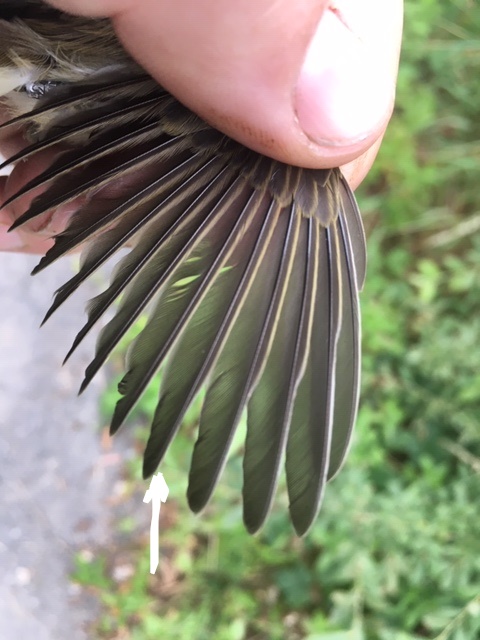As I mentioned in my last report, things have been a tad hectic at Belvide since the arrival of the Laughing Gull on Sunday afternoon. We've had lots of visitors to the reserve who generously donated almost £400 which we will be able to use to continue improving things for future visitors-and birds. Top birder Steve managed to get a picture of the Laughing Gull standing next to one of 'our' Black Headed Gulls which we colour ringed a couple of years ago and which has returned to breed. A pretty neat picture I think--with the Laughing Gull to the left:-
Last night we set the remaining nets for the 'Grand Opening' of the 2020 season this morning. Unfortunately this morning we were greeted at 05.00 with mizzle which seemed to dampen the birds' enthusiasm for getting busy. We had a slow start as a result but things picked up until we decided to call it a day ay 09.00.
65 new birds was a bit disappointing but actually, within that total there were some very interesting birds. As is usual for Belvide Sedge and Reed warblers made up the bulk of the catch--but we did have a few special birds--see later...…
It's great to see so many newly fledged birds around, illustrating that it's been a decent breeding season-and in Sedge warblers in particular there is a plumage feature which birders can see using optics which allows you to age juvenile Sedgies. Most of the juveniles have a more or less well developed 'necklace' of dark brown speckles round the throat--the bird in this picture had a reasonablywell developed one as you can see:-
We don't catch too many Bullfinches at the res, so this smart male was both stunning to look at-as well as being instructive for the trainees:-
The smartness is obvious--but it needs a close look at the area near the joint of the wing to see a particular ageing feature:-
Just below the thumb of the holder you can just make out one longish feather with a pale buff tip-and next to it a shorter feather with a dark buff tip. Both these feathers have been retained since the bird was first fledged--so we know this bird was definitely hatched in 2019.
The following bird was definitely hatched just a couple of weeks ago--and causes some people headaches trying to identify the species...…
Of course this is a baby Robin which has only recently left the nest--the speckled breast will be replaced by red feathers over the coming months--these speckles are thought to reduce the potential aggression from adult males until these youngsters can properly fend for themselves.
This Blackcap is an intriguing bird. At first glance I thought it was an adult male because the head looked black. However, on closer inspection, the black feathers are just coming through as they replace the brown feathers which all juvenile Blackcaps have when they leave the nest. The date here is only 1st July, so this bird must have been fledged sometime in May for it to have moulted these head feathers to this extent.
Finally, for the more common species, this Song Thrush again shows an ageing feature which you can see in the field:-
If you look carefully at the buff tips to the feathers in the middle of the wing you can see the tips are shaped like a rose thorn going up the feather shaft. This is a juvenile feature and these tips in older birds are rounded instead of thorn shaped.
I reckon it's impossible not to be impressed by Kingfishers, and although they are relatively common they always provide a boost during a ringing session. This is our first for this season--it's a juvenile female-the developing patch of red on the lower mandible of the beak shows it's female:-
I couldn't resist showing you a picture of the wonderful blue streak down the bird's back--often all you see as it zooms past along a river or canal:-
And last but by NO means least, we have had a new breeding species on the reserve this year, called a Cetti's Warbler. To be fair they are not the most colourful bird on Earth--but we have waited a long time for this coloniser from southern Europe to set up its stall at Belvide. We manged to ring both adults and two of their chicks--we are pretty sure they are raising a second brood as I write.
This is the adult female--males look exactly the same but they are measurably larger. As you can see--not especially pretty-but interesting on many levels--one of which is that they only have 10 tail feathers--unlike the vast majority of songbirds which have 12. I have no idea why!!
Here's a closer picture of the larger male, where you can see a bit more of the head features:-
Looking forward to our next session on Saturday morning.

































